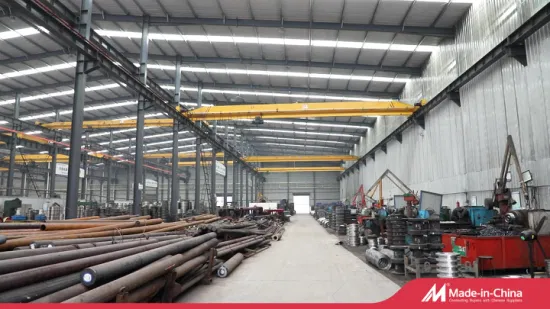
180
Overview A launching gantry (also called beam launcher, girder launcher,[bridge building crane, and bridge-building mach
Send your inquiryDESCRIPTION
OverviewBasic Info.
| Model NO. | 180-200t |
| Type | Lifting Equipment for Bridge Construction |
| Main Girder Form | Double Girder |
| Custom Specification | Support |
| Transport Package | Air Bubble Film/Nude Packing/Carton |
| Specification | Steel product |
| Trademark | ZHONGJIAN |
| Origin | China |
| Production Capacity | 50 Sets/Year |
Product Description
A launching gantry (also called beam launcher, girder launcher,[bridge building crane, and bridge-building machine, locally nicknamed the "Iron Monster") is a special-purpose mobile gantry crane used in bridge construction, specifically segmental bridges that use precast box girder bridge segments or precast girders in highway and high-speed rail bridge construction projects. The launching gantry is used to lift and support bridge segments or girders as they are placed while being supported by the bridge piers instead of the ground.
While superficially similar, launching gantry machines should not be confused with movable scaffolding systems, which also are used in segmental bridge construction. Both feature long girders spanning multiple bridge spans which move with the work, but launching gantry machines are used to lift and support precast bridge segments and bridge girders, while movable scaffolding systems are used for cast-in-place construction of bridge segments.
Typically, precast segmental bridges and precast girders are placed using ground-based cranes to lift each segment or girder. However, ground access to the spans may be challenged by the presence of existing infrastructure or bodies of water or the height to which the segments must be raised can exceed the reach of ground-based cranes. A launching gantry can be used to solve these issues.
The most visible feature of a launching gantry are the twin parallel girders which can either be above (upper-beam) or below (lower-beam or underslung) the bridge deck. However, a single beam can also be used, typically in upper-beam configuration. The launching gantry machine usually is sized to the construction project, with the length of the twin main girders approximately 2.3 times the distance between spans. This length enables the launching gantry to span the gap between two adjacent bridge piers while providing allowances for the distance required for launching to the next span and flexibility of movement to accommodate curved paths between piers. In some cases, hinges have been inserted into the gantry girders to allow tighter curves. The launching gantry girders are supported at each pier by braced frames which have a limited range of movement to facilitate placement of bridge segments or bridge girders; the launching gantry does not generally contact the bridge deck.
Two gantry trolleys can run the full length of the launching gantry girders. Each trolley is equipped with two winches: a main winch to suspend the load, and a translation winch to move the trolley along the girders. When bridge segments (or bridge girders) are delivered at the ground level, the launching gantry is used to pick them up and raise them to deck or pier height. If the segments (or girders) are delivered instead at the bridge deck level, the launching gantry moves back to allow the forward trolley to pick up the front end of the next segment (or girder), while the back end of the segment (or girder) is supported by the transportation vehicle; as the forward trolley moves forward, the rear trolley takes over supporting the back end from the vehicle.
Bridge segments (or bridge girders) are set in place by the launching gantry until the span between adjacent piers is completed. For segmental bridges, typically a span-by-span or balanced-cantilever approach is adopted to place segments. To free up the gantry trolley(s), temporary hangers are used to support each segment after it has been placed. In the span-by-span approach, all the segments for a span are placed before bridge tendons are tensioned; in this fashion, work progresses from one pier towards an adjacent pier. In the balanced-cantilever approach, segments are placed simultaneously on each side and work progresses from a central pier towards the two nearest piers instead. In either case, the launching gantry girders and hangers essentially serve as false work prior to tensioning.
Once the bridge span between adjacent piers is completed, the winches on the trolleys are used to lift the gantry girders and "launch" them ahead to the next span. The process of lifting and placing bridge segments (or girders) followed by launching the gantry girders ahead is repeated until the bridge is complete.
Launching gantries are often distinguished by the design of the main girders.
Honeycomb Girder:
The honeycomb girder launching gantry has been proven suitable to a lifting range of 5 to 300t.
The main girder of a honeycomb girder is fabricated from welded plates, forming an isosceles triangle cross-section. Regular hexagonal holes are cut in the inclined web plates to reduce wind resistance. Because the honeycomb girder is formed by relatively long seam welds joining plates, the welds will not lose integrity easily due to small welding defects.
Truss Girder:
The main girder of a truss girder is fabricated from welded steel poles. The welds in a truss girder are point-to-point (joining steel poles to other poles), which requires more stringent welding technology and technique. With small self-weight and large deflection, the truss girder launching gantry is suitable for highway bridge construction projects.
Box Girder:
The main girder of a box girder also is fabricated from welded plates. This type of girder is usually used in high-speed railway bridge construction projects.------------------------------------------------------------Design and manufacturing features---------------------------------------------------------------
- The Beam Launcher has many advantages, such as light weight, high stiffness, low deflection, and high wind-resistance.
- Unique steel pin connection, which is not only firm, but also easy to install.
- Flexible steel legs, convenient to disassemble and transfer.
- The frequency-converter can be installed according to the user's requirements.
- Customized Beam Launcher for bridges with span ranging from 20m to 70m.
- Beam feeding from rear end of the Beam Launcher on the deck level or from below on ground level or from bridge side.
- All Series Beam Launcher are designed to be fit into and deliver by 40 footer open top container.
- Beam Launcher comes with centralize control system, multi-speed Crane, Hydraulic powered Support, Mechanical powered Self Advancing system.
Product Parameters
| Model | JQG120/30m | JQG160/40m | JQG200/50m | JQG250/55m | JQG320/60m | |
| Capacity (t) | 2 x 60 | 2 x 80 | 2 x 100 | 2 x 130 | 2 x 160 | |
| Max. Span (m) | 30 | 40 | 50 | 55 | 65 | |
| Lifting Height (m) | 7 | 7.5 | 9 | 9 | 8.5 | |
| Lifting Speed (m/min) | 0.98~1.17 | 0.78~1.1 | 0.8~1.1 | 0.9~1.1 | 0.785~0.955 | |
| Work Duty | A3 | A3 | A3 | A3 | A3 | |
| Max. Slope of Longitudinal(%) | ± 4 | ± 4 | ± 4 | ± 4 | ± 4 | |
| Transverse Speed of Trolley(m/min) | 2.16 | 2.3 | 2.3 | 2.3 | 1.985 | |
| Min. Applicable curve Radius(m) | 300 | 300 | 300 | 300 | 300 | |
| Speed of Longitudinal Truss Car(m/min) | 3.24 | 0~4 | 0~4 | 0~4 | 0~5.08 | |
| Max. Slant Angle | 45º | 45º | 45º | 45º | 45º | |
| Longitudinal Speed of Main Girder Travel(m/min) | 3.37 | 0~4 | 0~4 | 0~4 | 0~5.08 | |
| Transverse Speed of Whole Crane(m/min) | 2.13 | 2.13 | 2 | 2 | 2.03 | |
| Max. Jacking of Hydraulic Front Leg(KN) | 2 x 600 | 2 x 800 | 2 x 1000 | 2 x 1200 | 2 x 1600 | |
| Max. Jacking of Hydraulic Middle Leg(KN) | 2 x 600 | 2 x 800 | 2 x 1000 | 2 x 1200 | 2 x 1600 | |
| Max. Jacking of Hydraulic Rear Leg(KN) | 2 x 400 | 2 x800 | 2 x 1000 | 2 x 1000 | 2 x 1200 | |
| Theoretical Operation Effiency(hour/pieces) | 0.5 ~ 1.2 | 0.5 ~ 1.2 | 0.5 ~ 1.2 | 0.5 ~ 1.2 | 0.5 ~ 1.2 | |
| Total Power(Kw) | 76.1 | 84.7 | 103.3 | 155.6 | 208.2 | |
| Total Weight(t) | ≈117 | ≈156 | ≈218 | ≈345 | ≈433 | |
| Dimension | W | 53182 | 67632 | 87380 | 95611 | 114808 |
| L | 30000 | 40000 | 50000 | 55000 | 65000 | |
| D | 7600 | 7600 | 7600 | 8000 | 9800 | |
| d | 4500 | 4500 | 4600 | 4800 | 5600 | |
| A | 14488 | 9739 | 9645 | 10300 | 13380 | |
| a | 9500 | 9500 | 9500 | 10232 | 12000 | |
| H | 7910 | 8270 | 8916 | 9943 | 10925 | |




Related Products
-
![Goods Yard 10 Ton Single Girder Box Type Gantry Crane with Hoist]()
Goods Yard 10 Ton Single Girder Box Type Gantry Crane with Hoist
-
![Lh Model Electric Hoist Overhead Crane 5t 10t 16t 20t 32t]()
Lh Model Electric Hoist Overhead Crane 5t 10t 16t 20t 32t
-
![Dy Workshop Electric Hoist Single Double Girder Beam Eot Overhead Bridge Crane 2 3 5 8 10 12 16 25 100 Ton T 1ton 2ton 3ton 5ton 8ton 10ton 12ton 16ton 25ton]()
Dy Workshop Electric Hoist Single Double Girder Beam Eot Overhead Bridge Crane 2 3 5 8 10 12 16 25 100 Ton T 1ton 2ton 3ton 5ton 8ton 10ton 12ton 16ton 25ton
-
![Stainless Fastener Crane Rigging Hardware Lifting Accessory]()
Stainless Fastener Crane Rigging Hardware Lifting Accessory











